Trampoline is used for competitive and recreational use. It can be set in the backyard or a park for people to enjoy jumping up and down. As they are made to withstand heavy weights, they are also prone to breaking after extensive use. Is it possible to repair a bent trampoline? Can you weld a trampoline frame?
Yes, you should be able to weld a ruptured trampoline frame or poles without much worry. Welding is a process where metal components are melted to adjoin one piece to another much more strongly.
The most common occurrence is the bending of the trampoline poles and raptures on the frame. These issues can be fixed using hammers and adjustable wrenches, but if the damage is too severe, then welding might help. Let’s figure out what kind of repairs are possible to do on a busted trampoline.
What Is a Trampoline?
It is a piece of gymnastic equipment that can be used to do acrobatics by jumping up and down. A trampoline is made using a stretched fabric that is supported by a frame. Trampolines come in different varieties and sizes. It has a good weight withstanding capability and is known to be sturdy.
A trampoline can accommodate kids and adults depending on its category. Small trampolines have a capacity of 50 lbs minimum and can go up to 150lbs, whereas the adult rebounders can hold up to even 600 lbs without breaking.
Why Do Trampolines Break?
As you already know that it is a rugged piece of equipment made to accommodate ranging weights, but the chances of trampolines getting damaged can’t be overlooked.
With time the springs on a trampoline can stretch further and lose their efficacy. Weather conditions can take a toll on the frames and spring making them rust.
The screws can come off, springs can weaken and snap, resulting in a warped trampoline frame. As the frame is metal construction, there are numerous reasons why some parts can come off and depreciate the overall value. The impairment occurs mostly due to wear, and they are fixable in most cases.
Common Damages on a trampoline
Trampolines are a popular source of outdoor entertainment and exercise for children and adults alike. However, like any other piece of equipment, trampolines are susceptible to wear and tear over time. Several factors can contribute to damage on a trampoline, and it is essential to identify and address these issues promptly to ensure safety and maintain the trampoline’s functionality. In this article, we will discuss common damages that can occur on a trampoline and provide guidance on how to address them effectively.
Frame Damage:
The frame of a trampoline provides structural support and stability. Over time, the frame can experience damage due to various factors such as exposure to harsh weather conditions, frequent use, or poor maintenance. Signs of frame damage may include bent or twisted metal, cracks, or rust. If left unaddressed, frame damage can compromise the trampoline’s integrity, leading to potential accidents and injuries.
Solution: Inspect the frame regularly for any signs of damage. If you notice bent or twisted metal, cracks, or rust, it is crucial to address these issues promptly. Depending on the severity of the damage, you may need to repair or replace the affected parts or the entire frame. Consult the manufacturer’s guidelines or seek professional assistance to ensure proper repairs.
Springs and Elastic Bands:
Springs or elastic bands play a vital role in providing bounce and tension to the trampoline mat. Continuous use, exposure to weather elements, or improper installation can cause springs to stretch, lose tension, or break. Similarly, elastic bands can weaken or snap over time, affecting the trampoline’s performance.
Solution: Regularly inspect the springs and elastic bands for signs of wear and tear. Replace any damaged or broken springs immediately to maintain proper tension and bounce. When replacing springs or elastic bands, ensure you use the appropriate size and follow the manufacturer’s recommendations. Proper maintenance and periodic lubrication can help prolong the lifespan of these components.
Mat Damage:
The trampoline mat is subject to significant wear and tear due to frequent jumping, exposure to UV rays, and weather elements. Over time, the mat may develop holes, tears, or frayed edges, compromising its structural integrity and safety.
Solution: Inspect the trampoline mat regularly for any signs of damage. Small holes or tears can often be repaired using a patch kit specifically designed for trampoline mats. However, larger or extensive damage may require replacing the entire mat. Ensure that the replacement mat meets the specifications recommended by the trampoline manufacturer.
Safety Net and Enclosure Damage:
Trampolines equipped with safety nets and enclosures provide an additional layer of protection to prevent falls and injuries. However, these components can also suffer damage from prolonged exposure to sunlight, wind, or heavy impact.
Solution: Regularly inspect the safety net and enclosure for any signs of damage, including holes, tears, or weakened attachments. Repair or replace damaged components promptly to ensure the trampoline remains safe for use. Follow the manufacturer’s instructions when installing or replacing the safety net and enclosure.
Padding and Protective Cover Damage:
The padding and protective cover surrounding the trampoline’s frame and springs help prevent accidental contact with hard surfaces. Over time, these components can deteriorate due to UV exposure, weather conditions, or repeated impact, rendering them less effective in ensuring user safety.
Solution: Regularly inspect the padding and protective cover for signs of wear, tears, or disintegration. Replace damaged or worn-out padding and covers with suitable replacements recommended by the manufacturer. Ensure that the new padding adequately covers all springs and the frame to provide optimal protection.
What Can Cause Trampoline Frame Damage?
Impairments can happen at any time, it could be due to component fatigue or simply because you’ve overused it and reached the breaking limit. Weather conditions can be another factor and must not be overlooked.
Frame damage can occur because of carrying excessive weight or maybe due to some internal issues such as toiled springs, missing parts, rusty metal, etc, which can take down parts of the trampoline or even the whole frame at once.
Ideal Fixes for Damaged Trampolines
If the damage is minimal to somewhat recoverable, we suggest you perform a repair job rather than throwing the trampoline away. Below are some ways described to revive a flawed trampoline.
Welding the Fractured Areas of the Frame
Whenever you observe a crack or some breaks on metal parts, you might wonder what’s wrong with it. Should you replace it, throw it away or can you weld a trampoline frame to make it better?
What we suggest is to look for the seriousness of the damage. If the frame and poles are wrecked to a limit beyond recovery, then there is no chance you can successfully retrieve your trampoline. It’s better to replace the parts if available or get a new trampoline.
If you see that there are disjointed areas and minor raptures in the metal parts, then welding can be a wise solution. It is believed that welding can even improve the structural integrity of a previously beaten frame.

The Welding construction method works by melting metal components and joining the abnormalities to produce a faultless structure. If you want to solder your damaged metal, then you will be hampering it further.
Soldering is not what welding offers, it is a process where low temperatures are used to join smaller breaks, whereas welding can affix critical disfigurements.
Straightening the Trampoline Legs
In terms of broken legs, you need to replace the parts completely. Welding can help in case the legs have minor cracks. In most cases, trampoline legs start to bend, and this is where straightening a trampoline can be helpful.
You must use a squeezer tool, adjustable spanner, and sleeve tube to put the bend pieces back to their initial position. Use the sleeve tube to slide where the trampoline legs bend, then use a hammer to straighten the material.
Let’s check a video about how to repair a broken leg-
Putting the Bent Trampoline Frame Back to Its Initial Position
This is a process where you have to bend back the frames to refix the issue. It might sound easy, but it is not. If a frame is bent, it is wise to be careful while you try to bend it in the opposite direction. There are chances that the frame might crack, so you better be cautious.
Turning the bent trampoline can be done using a hammer and clamps. You need to use ideal pressure to the bent side so that it goes back into its ideal position. The process might not be flawless, don’t expect it to be because you are already putting excessive work on the bent poles.
While you perform this action, keep an eye on the frame and pole joints. If you see them cracking, then there is no use in bending them back. You better replace the frame components in such scenarios.
Simple way to repair a trampoline
Final Verdict
To those who have been asking, can you weld a trampoline frame? Well, yes you can! It can help to adjoin the broken bits and cover any cracks permanently. First, you must look for the reason behind the casualty.
Now check the severity of the problem. If there are some minor fragment issues, they can certainly be fixed using welding.
Extreme frame impairments should be dealt with by replacing the corrupted parts. For frames that have been destroyed completely, you better go for new jumping equipment rather than fixing and wasting time.
Don’t take a trampoline for granted. It is made of metal parts, and thus, there are chances it will deteriorate. Good thing is that it can be serviced, and if taken care of, your trampoline is destined to last for ages.
Frequently Asked Question
Can I weld a trampoline frame myself?
Welding a trampoline frame requires expertise and knowledge of the materials used. It is recommended to consult a professional welder.
What materials are trampoline frames typically made of?
Trampoline frames are commonly made of galvanized steel or aluminum, chosen for their strength, durability, and resistance to rust and corrosion.
What type of welding is suitable for trampoline frames?
MIG (Metal Inert Gas) welding is commonly used for trampoline frames due to its strong bond and relative ease of use.
Can I use any welding equipment for trampoline frame welding?
You will need a welding machine capable of MIG welding, with appropriate power and settings for the frame material. Consult professionals for recommendations.
Are there any risks associated with welding a trampoline frame?
Yes, risks include burns, electrical hazards, and the release of harmful fumes. Take necessary safety precautions or consult a professional welder.
Last Updated on August 25, 2023

